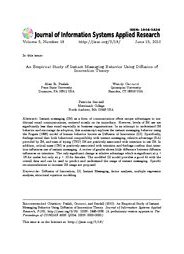Volume 3
Volume 3, Number 18 |
June 15, 2010 |
Abstract: Instant messaging (IM) as a form of communication offers unique advantages to traditional email communications, centered mostly on its immediacy. However, levels of IM use are significantly less than email especially in business organizations. In an attempt to understand IM behavior and encourage its adoption, this manuscript explores the instant messaging behavior using the Rogers (1995) model of human behavior known as Diffusion of Innovation (DI). Specifically, findings reveal that both behavioral compatibility with instant messaging, relative advantage (RA) provided by IM, and ease of trying (TRY) IM are positively associated with intention to use IM. In addition, critical mass (CM) is positively associated with intention and findings confirm that intention influences use of instant messaging. A review of gender shows little difference between diffusion influences on intention. The only significant change is relative advantage which is significant at p < .05 for males but only at p < .10 for females. The modified DI model provides a good fit with the overall data and can be used to predict and understand the usage of instant messaging. Specific recommendations to increase IM usage are proposed.
Keywords: Diffusion of Innovation, DI, Instant Messaging, factor analysis, multiple regression analysis, structural equation modeling
Download this issue: JISAR.3(18).Peslak.pdf (Adobe PDF, 13 pages, 682 K bytes)
Preview the contents: Peslak.j.txt (ASCII txt, 29 K bytes)
Recommended Citation: Peslak, Ceccucci, and Sendall (2010). An Empirical Study of Instant Messaging Behavior Using Diffusion of Innovation Theory. Journal of Information Systems Applied Research, 3 (18). http://jisar.org/3/18/. ISSN: 1946-1836. (A preliminary version appears in The Proceedings of CONISAR 2008: §3334..)
